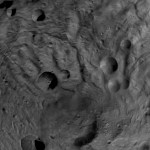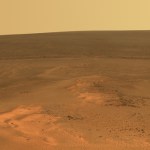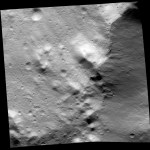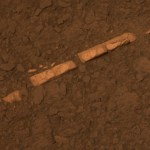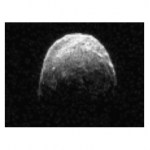Cosmos
Vesta is the second biggest asteroid in the famous asteroid belt between Mars and Jupiter. It has generally been thought that Vesta would get enough sun over its entire surface that water would not survive, but a recent survey of the surface indicates that deeply buried water has a chance of remaining on the asteroid near the poles, or possibly at the bottom of some deep craters.
Vesta Up Close (image by NASA)
This is interesting, in part, because of questions about the role of water in the early formation of the solar system. One of the main objectives of the Dawn spacecraft mission is to…
Can you imagine driving around on roadless terrain with a four wheel drive vehicle for eight years and not ever changing a tire, getting a tuneup, adjusting the suspension, replacing the hydraulics or brakes, or doing any other service whatsoever on your vehicle? I've actually done that, and I'm here to tell you, you can't do that!
But Mars Exploration Rover Opportunity has, in fact, done it.
Opportunity was tasked to took around on the Martian surface for three months. The Space Robot landed on Mars on January 25th, 2004. During the last eight years, Opportunity has traveled great…
There is a story going around that there is evidence of life on Venus. The evidence would be very convincing if some descriptions of it were true: Scorpion or crab like creatures walking around on the surface sounds a lot like life to me! And, the research is published in a peer reviewed journal put out by one of the big publishing houses, and the paper is by a mainstream Russian scientist who's done a lot of work. But is seems to be very wrong.
The research is by Leonid Ksanfomaliti, and looks at photographs from the 1980s period landing probe. What looks a lot like a crab seen in two…
According to one study, yes.
Using a technique called gravitational microlensing, an international team found a handful of exoplanets that imply the existence of billions more.
The findings were released at the 219th American Astronomical Society (AAS) meeting, alongside reports of the smallest "exoplanets" ever discovered.
Gravitational microlensing is a method that uses the gravity of a far-flung star to amplify the light from even more distant stars that have planets.
Astronomers used a number of relatively small telescopes that make up the Microlensing Network for the Detection of Small…
... outside our solar system.
Kepler has discoverd theree planets around the star KOI-961, and they are a mere 0.78, 0.73 and 0.57 times the radius of Earth, rocky like the earth, but alas, they are too close to the star so there can't be any liquid water on them. But still, there are hardly any rocky exoplanets known, and the small ones are hard to find.
And the possibility of life being on them is, well, just have a look:
Here's the NASA press release on this new finding.
The Gravity Recovery and Interior Laboratory, which will neither be recovering gravity or being inside the moon but "GRAIL" apparently sounds good, is coming into Lunar Orbit as I write this.
As you know from watching Apollo 13 the travel distance to or back from the moon is a matter of several days ... Apollo crews got there in about three Earth Days. But the GRAIL mission has taken months to get there, because of the kind of orbit they wanted to achieve. Also, the long duration allows for other things to happen, like temperatures to stabilize within the machinery.
GRAIL is two space ships…
This image, one of the first obtained by NASA's Dawn spacecraft in its low altitude mapping orbit, shows an area within the Rheasilvia basin in the south polar area of the giant asteroid Vesta. Image credit: NASA/ JPL-Caltech/ UCLA/ MPS/ DLR/ IDA
NASA's Dawn spacecraft has sent back the first images of the giant asteroid Vesta from its low-altitude mapping orbit. The images, obtained by the framing camera, show the stippled and lumpy surface in detail never seen before, piquing the curiosity of scientists who are studying Vesta for clues about the solar system's early history.
At this…
First, there were big-giant planets discovered orbiting other stars. Then, more recently, a planet in the star's Goldilocks Zone ... where water would be at least sometimes liquid, were it present. But that was a big planet that may or may not have been truly "class M" in having a surface, atmosphere, etc.
Now, NASA reports planets the size of the earth beyond our solar system. Unfortuntely, they are not in the zone. But still, this is cool.
NASA's Kepler mission has discovered the first Earth-size planets orbiting a sun-like star outside our solar system. The planets, called Kepler-20e…
I'm not sure exactly what this means, but ...
A respected scientist from the Cern particle physics laboratory has told the BBC he expects to see "the first glimpse" of the Higgs boson next week.
...Next Tuesday, two separate teams will each reveal the outcome of trawling through their latest data from LHC collisions. A spokesman for one of these teams told us that this year alone they've searched the remains of some 350 trillion collisions, with only ten or so producing candidates for a reliable sign of the Higgs.
bbc
Anybody got any inside info?
This is very, very cool.
Geologically, there are ways in which minerals move around and get deposited with rock. A common phenomenon is for a crack to form due to cooling of molten rock or an earthquake or something, and then this space gets filled in. Stuff might just fall into it. Liquidizer rock (magma) might intrude into it. Hot gasses containing residue might build up a deposit within it, or liquid water might flow through it leaving behind minerals, which fill the crack. The thing is, geologists have studied these processes and have a pretty good idea of what they are, how they…
First, I should say right away that the planet that has been in the news so much lately is not known to be "earth like" ... depending on what you think "earth like" is. What we know is that the planet orbits its star in a position that allows for the possibility that water on its surface could be liquid. But, the possibility that the planet has a "surface" ... as opposed to some increasingly dense gaseous layer like Neptune ... has not yet been established. Not that this would favor life one way or another. For all we know, getting life started on a hard crust covered earth is way harder…
... and probably has been there for months, but new research is confirming the nature of this very interesting phenomenon. It is the outer edge of our solar system, where fast moving stuff heading away from the sun has slowed down because it's movement is stifled by gravity, but some extra-energetic particles are still leaking out into the greater galactic region, from which they are unlikely to return. Also, the solar system's magnetic fluxy stuff is bunched up in this region.
The cool thing about this is that we don't really know exactly what is happening. Enough is known about the solar…
Maybe. Well, not really. But it could be ....
NASA's Kepler mission has confirmed its first planet in the "habitable zone," the region around a star where liquid water could exist on a planet's surface. Kepler also has discovered more than 1,000 new planet candidates, nearly doubling its previously known count. Ten of these candidates are near-Earth-size and orbit in the habitable zone of their host star. Candidates require follow-up observations to verify they are actual planets.
The newly confirmed planet, Kepler-22b, is the smallest yet found to orbit in the middle of the habitable zone…
I remember my first solar eclipse. I was a kid, and it was the one Carlie Simon sang about, in March 1970.
(The eclipse reference is just past three minutes. Some other time we can argue over whether or not Carlie, singing in this video on Martha's Vineyard, was referring to the March 1970 eclipse or the July 1972 eclipse, but I'm sure it was the former, because that's the one everybody got all excited about.)
I was such a geek that I actually missed the eclipse because I was busy collecting data. There was a phone number you could call and a lady's voice would give you the time and…
YU55 is in the vicinity now, and will pass within the Moon's orbit tomorrow. NASA sent me a pretty crappy image but I fixed it up for you:
The image was taken on Nov. 7 at 11:45 a.m. PST (2:45 p.m. EST/1945 UTC), when the asteroid was approximately 860,000 miles (1.38 million kilometers) away from Earth. Tracking of the aircraft carrier-sized asteroid began at Goldstone at 9:30 a.m. PDT on Nov. 4 with the 230-foot-wide (70-meter) antenna and lasted about two hours, with an additional four hours of tracking planned each day from Nov. 6 - 10.
The asteroid safely will safely fly past our…
PASADENA, Calif. -- A new NASA study suggests if life ever existed on Mars, the longest lasting habitats were most likely below the Red Planet's surface.
A new interpretation of years of mineral-mapping data, from more than 350 sites on Mars examined by European and NASA orbiters, suggests Martian environments with abundant liquid water on the surface existed only during short episodes. These episodes occurred toward the end of a period of hundreds of millions of years during which warm water interacted with subsurface rocks. This has implications about whether life existed on Mars and how…
By Dr. Gerry Harp, Senior Astrophysicist, Center for SETI Research, SETI Institute, and Gail Jacobs
Trained as a quantum mechanic, Dr. Gerry Harp was deeply interested in possibilities for using the multiple telescopes of the Allen Telescope Array to generate steerable "beams" on the sky -- beams that could be far smaller than any single antenna could produce. Such beams don't emit anything, but work in reverse by capturing only energy that comes from the sky in a certain direction. Gerry joined the SETI Institute in 2000, practically at the telescope's inception and uses the telescope for…
